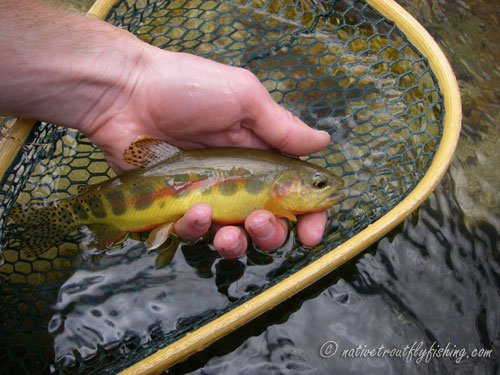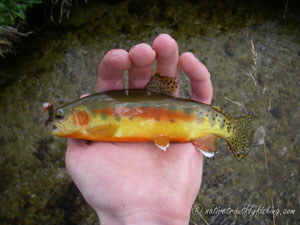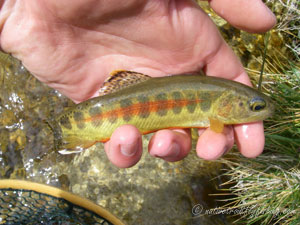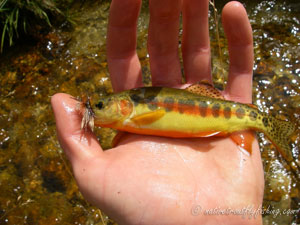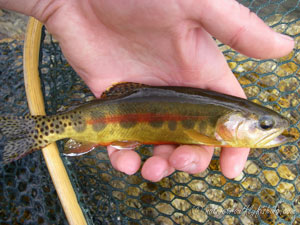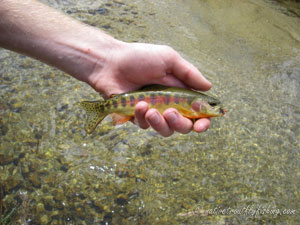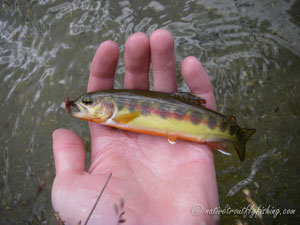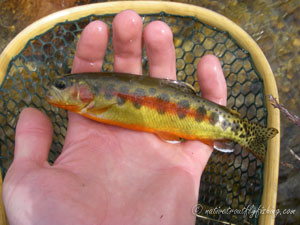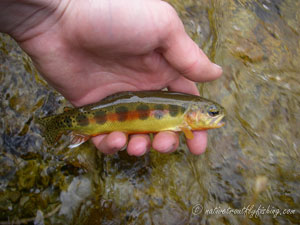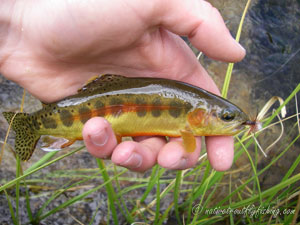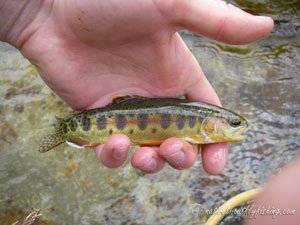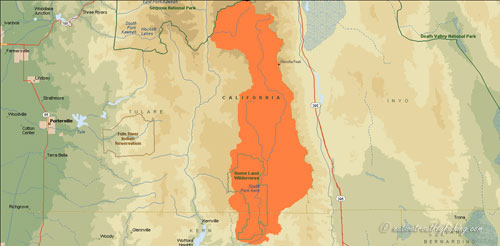California Golden Trout
Oncorhynchus mykiss aguabonita
A California Golden Trout from a small high Sierra stream
Introduction
The California Golden Trout is often considered the most beautiful of the salmonids. These fish are native to the South Fork of the Kern River and Golden Trout Creek in the southern Sierra-Nevada Mountains of California and historically occupied approximately 450 miles (725 km) of stream habitat (Trout Unlimited 2007). The fish in Golden Trout Creek have a brighter coloration and originally, they were considered a distinct subspecies Salmo aguabonita roosevelti (Evermann 1905), however genetics and meristic characters do not support this classification (Moyle 2002). The classification of California Golden Trout has been in debate since their discovery. Early classifications considered them Cutthroat, although it became apparent that they fall in the Rainbow Trout lineage (Behnke 2002). Recently, the American Fisheries Society considered Golden Trout a full species Oncorhynchus aguabonita, reasoning that they do not naturally mix with Rainbow Trout across their native range (Moyle et al. 2017). However, as it appears that interbreeding between Rainbow Trout and Golden Trout resulted in the Kern River Rainbow Trout (Moyle 2002), this assumption does not appear to be valid. Due to its beauty and popularity with anglers the California Golden Trout has been widely stocked outside of its native range, especially in the high lakes of the Sierra Nevada and Rocky Mountain Ranges. The hatchery broodstock used for stocking Golden Trout outside their native range is slightly hybridized with hatchery Rainbow Trout, but still predominately retains the appearance of the Golden Trout (Behnke 2002).
Life History Information
The habitat available within the native range of the California Golden Trout consists of small high-altitude streams, and as such these fish only exhibit a stream resident life history type. The typical size of the home range for adult Golden Trout is generally 55 to 165 ft (17 to 50 m) of stream habitat, although ranges of up 1,800 ft (549 m) have been observed (Matthews 1996). Golden Trout prefer undercut banks or areas with sedge, although they also utilize several other types of habitat such as pools and runs as well. California Golden Trout typically spawn for the first time at age-3 to age-4 and like other the subspecies of Rainbow Trout are spring spawning fish (Stefferud 1993). In the high-altitude streams of the upper Kern Basin, spawning occurs after runoff has subsided and water temperatures have warmed up to above 50° F (10° C), which ranges from mid-May through July depending on the altitude (Knapp and Vredenburg 1996). Knapp et al. (1998) showed that California Golden Trout used smaller gravel, shallower areas and dig shallower redds than other salmonids and Golden Trout eggs generally hatch in around 20 days, with fry emerging from the two weeks after that (Moyle et al. 2017). Growth in the high-altitude streams of the upper Kern basin is slow and these fish typically only grow about an inch (2 cm) a year with a maximum size of around 8” (20 cm) and a maximum age of 9 years old in most streams (Knapp and Dudley 1990). Stream resident California Golden Trout are drift feeders and prey primarily on aquatic and terrestrial insects, rarely refusing a meal when available.
Status
Even though the California Golden Trout is the official state fish of California, poor past management has put them at a serious risk of extinction. As early as 1903, there were concerns that California Golden Trout were at risk of extinction, prompting then President Theodore Roosevelt to order investigations of the trout of the upper Kern Basin (Evermann 1905). These early concerns were primarily around the restricted range of the California Golden Trout, as well as the ease at which they could be caught and harvested. However, it became apparent that as the California Golden Trout have long been isolated from contact with other species of trout, their greatest threat is the introduction of non-native fish (Gold and Gold 1976). Introduced Brook Trout compete with them for food, Brown Trout prey on them and Rainbow Trout hybridize with them, leading to a loss of their genetic integrity. Cordes et al. (2006) showed that hybridization with introduced rainbow trout threatens the genetic integrity of California Golden Trout across their entire native range. Although the degree of hybridization varies from population to population, it is believed that the only completely pure population occurs in about a three mile stretch of Volcano Creek (Moyle et al. 2017). In the South Fork of the Kern River, hybridization ranged from 2% in Upper Mulkey Creek to 29% in Upper Trout Creek (Stephens 2007) and 94% in lower Kennedy Meadows. In addition to the introduction of hatchery Rainbow Trout, Brown Trout have been introduced to the South Fork of the Kern River and are a significant predator of California Golden Trout.
While the introduction of non-native fish is the greatest threat to the California Golden Trout, degraded habitat conditions also pose a serious problem. To address these issues Congress designated the 306,000 acre (1,238 km2) Golden Trout Wilderness area in 1978, however grazing practices and recreational use continue to impact this area to this day. Livestock grazing has occurred in the California Golden Trout's native range since the 1800's with cattle and sheep being the primary animals that are raised in the area. The preferred habitat for California Golden Trout is wider stream reaches that are typically associated with cattle grazing and due to extensive damage to the riparian habitat, starting in 1991, meadow restoration and cattle exclusion areas were implemented in parts of the Golden Trout Wilderness Area. Knapp and Mathews (1996) showed that un-grazed stream reaches in the Golden Trout Wilderness had significantly higher densities and biomasses of trout compared to those that were grazed. Un-grazed areas also had greater canopy shading, stream depth and smaller stream widths then what was found in grazed areas. While there has been a push to re-open these areas to grazing in recent years, an economic benefits analysis from 2003 indicated that recreational fishing in the Golden Trout Wilderness Area generates $148,000 to $713,000 annually, compared to ~$35,000 a year from grazing (Alkire 2003). Additionally, despite being rested from cattle grazing for 25 years, the vegetation in many areas has still not fully recovered (Nusslé et al. 2017).
As California Golden Trout have a low tolerance of stream temperatures over 75° F (24° C) (Gold and Gold 1976), increased stream temperatures from climate change presents another threat to these fish (Matthews and Nusslé 2015). Nusslé et al. (2015) showed that stream reaches where cattle were excluded were cooler due to shade from overhanging vegetation then grazed reaches, helping to buffer potential impacts from climate change. However, during drought years such as those from 2013-2017, the California Department of Fish and Wildlife had had to step in to ensure that the pure California Golden Trout populations were not lost. In 2016, the abundance of Golden Trout in Volcano Creek got so low due to high water temperatures and stream dewatering, that 42 fish had to be rescued and brought into a hatchery as a safeguard against losing the population. Luckily conditions improved and the fish were released back into the wild, but with a record drought setting in 2021 again, efforts such as this may be needed again. While the future of the California Golden Trout is unclear, there is hope that improved management of these fish will ensure their existence into the future.
Description
The California Golden Trout is perhaps the most brilliantly colored salmonid. The backs of these fish can range from a bronze or copper color to dark-olive, which transitions to a golden-yellow color that becomes intense below the lateral line. The belly in most individuals is a bright-orange color, but the intensity of this coloring varies with age, size and maturity of the fish. Dark purple parr marks are present into maturity in stream resident California Golden Trout but have been known to fade on larger fish stocked in lakes outside their native range. There is a red or pink stripe along the lateral and the same coloration is found on the gill plates. The fins are an orange or yellow color, and the dorsal, anal and pelvic fins have a dark border outlined with white, or orange on the dorsal fin. The spots are round, large to moderate in size and are isolated above the lateral line and on the dorsal and caudal fins. Often the spots are concentrated near the tail on the caudal peduncle, as is also common in many subspecies of Cutthroat. This coupled with the fact that these fish also typically have orange Cutthroat marks led to a great deal of confusion to whether Golden Trout should be aligned with Cutthroat or Rainbow Trout, which has since been cleared up by genetics.
Stream Resident Form
Click on images to view a larger picture
Native Range
A map of the native range of the California Golden trout. Data Source: Behnke (2002).
References
Alkire, C. 2003. Economic value of Golden Trout fishing in the Golden Trout Wilderness, California. Report for California Trout.
Behnke, R. 2002. Trout and Salmon of North America. Chanticleer Press, New York.
Cordes, J.F, Stephens, M.R., Blumberg, M.A., and May, B. 2006. Identifying introgressive hybridization in native populations of California Golden Trout based on molecular markers. Transactions of the American Fisheries Society 135: 110-128.
Gold, M.F. and J.R. Gold. 1976. Golden Trout in trouble. Natural History LXXXV(10): 74-84.
Knapp, R. and T. Dudley. 1990. Growth and longevity of Golden Trout, Oncorhynchus aguabonita, in their native streams. California Fish and Game 76: 161-173.
Knapp, R.A. and Matthews, K.R. 1996. Livestock grazing, Golden Trout and streams in the Golden Trout Wilderness, California: Impacts and management implications. North American Journal of Fisheries Management 16: 805-820.
Knapp, R.A. and Vredenburg, V.T. 1996. Spawning by California Golden Trout: Characteristics of spawning fish, seasonal and daily timing, redd characteristics, and microhabitat preferences. Transactions of the North American Fisheries Society 125: 519-531.
Knapp, R.A., Vredenburg, V.T., and Matthews, K.R. 1998. Effects of stream channel morphology on Golden Trout spawning habitat and recruitment. Ecological Applications 8(4): 1104-1117.
Matthews, K.R. 1996. Diel movement and habitat use of California Golden Trout in the Golden Trout Wilderness, California. Transactions of the American Fisheries Society 125: 78-86.
Matthews, K.R. and S.C. Nusslé. 2014. California Golden Trout and climate change: Is their stream habitat vulnerable to climate warming? Wild Trout Symposium XI—Looking Back and Moving Forward: Session 1: Role of Ecological Resilience in Wild Trout Management 51-57.
Moyle, P. 2002. Inland Fishes of California, 2nd Edition. Berkeley, University of California Press.
Moyle, P.B., R.A. Lusardi, P.J. Samuel and J.V.E. Katz. 2017. State of the salmonids: status of California's emblematic fishes 2017. Center for Watershed Sciences, University of California, Davis and California Trout, San Francisco, CA. 579 pp.
Nusslé, S., K.R. Matthews and S.M. Carlson. 2017. Patterns and dynamics of vegetation recovery following grazing cessation in the California Golden Trout habitat. Ecosphere 8(7): e01880. https://doi.org/10.1002/ecs2.1880
Nusslé, S., K.R. Matthews and S.M. Carlson. 2015. Mediating water temperature increases due to livestock and global change in high elevation meadow streams in Golden Trout Wilderness. PLoS ONE 10(11): e0142426. https://doi.org/10.1371/journal.pone.0142426
Stefferud, J.A. 1993. Spawning season and microhabitat use by California Golden Trout (Oncorhynchus mykiss aguabonita) in the Southern Sierra Nevada. California Fish and Game 79(4): 133-144.
Stephens, M.R. 2007. Systematics, genetics and conservation of Golden Trout. Dissertation. University of California, Davis, California.
Trout Unlimited. 2007. California Golden Trout. Retrieved Dec. 30, 2008, from http://www.tucalifornia.org/cgtic/CGTbasics.htm
Contact
Feel free to contact me if you have any questions or comments
California Golden Trout Links
My California Golden Trout Trips
California Department of Fish and Wildlife - California Golden Trout Angling
Cal Trout - California Golden Trout
Western Native Trout Initiative - California Golden Trout
Native Trout Links
Truchas Mexicanas' - Native Trout of Mexico
Balkan Trout Restoration Group
Trout and Seasons of the Mountain Village - About Japanese Trout
Western Native Trout Challenge
California Heritage Trout Challenge
Fly Fishing Blogs
Dave B's Blog: Fly Fishing for Native Trout
The Search for Native Salmonids
Conservation Links
Western Native Trout Initiative
Fly Fishing Links
Fishing Art Links
Americanfishes.com - Joseph R. Tomelleri
